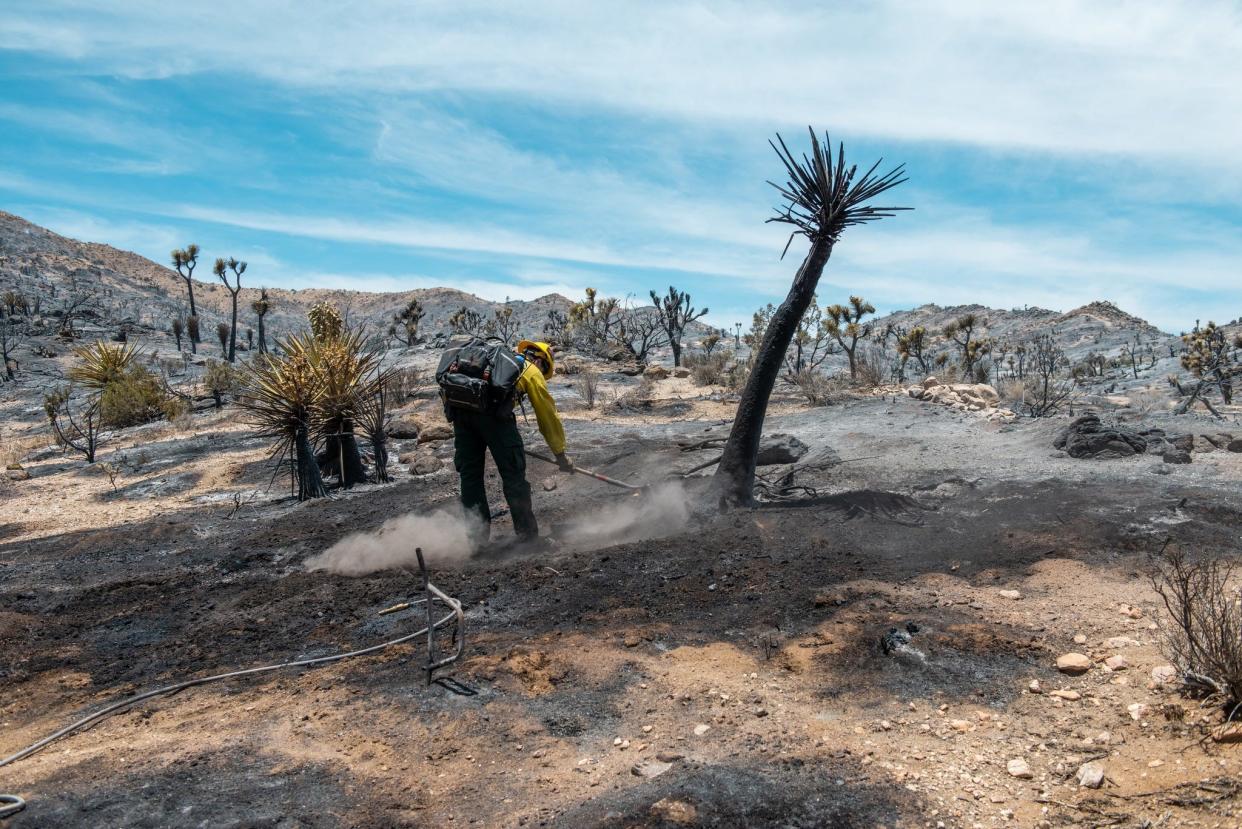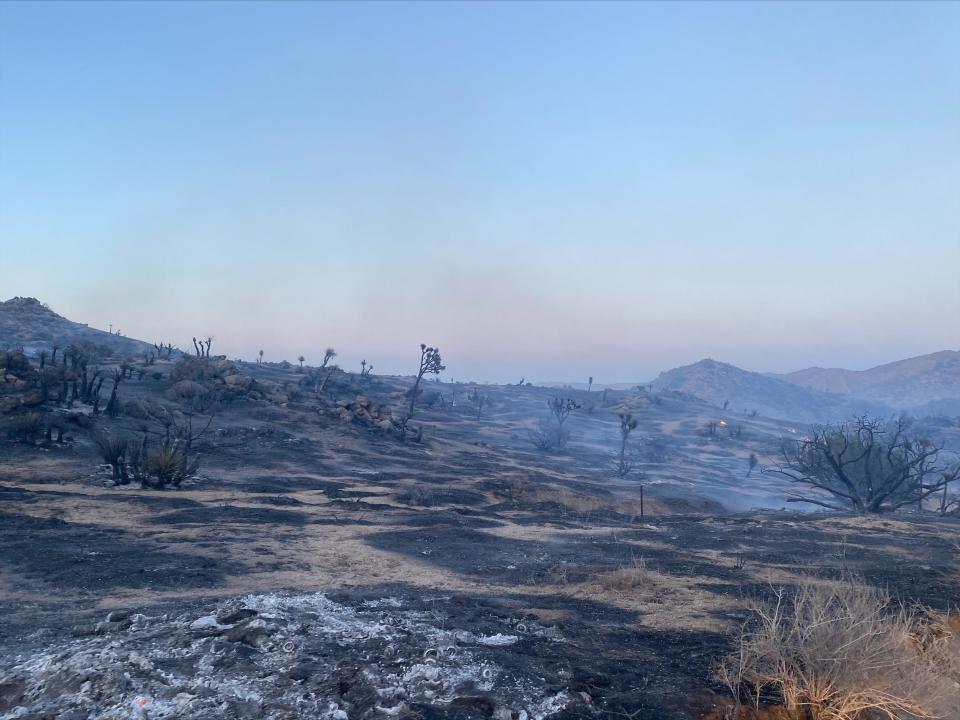How invasive grasses, smog from LA help fires spread in Joshua Tree National Park

A fire that burned 170 acres of Joshua Tree National Park at the end of April likely wouldn't have spread more than a quarter-acre before 1965. The culprit? A combination of air pollution, drought, invasive grasses, and human activity that have resulted in larger and more frequent fires in Joshua Tree National Park.
The Elk Fire, which San Bernardino County Sheriff's deputies say was sparked by two teenage campers last week near San Andreas Road on the southwest side of Yucca Valley, was 100% contained within a few days, but not before it burned through 431 acres of Mojave Desert landscape, including the 170 acres in the park.
Unlike forest ecosystems, wildfire is not a natural part of desert ecosystems.
Joshua Tree National Park’s native shrubs and trees are widely spaced out, and the nutrient-poor desert soil historically meant there has been limited fuel to feed a fire’s spread. But in the past few decades, invasive grasses have thrived as smog dumps nitrogen onto the desert soil, allowing fires like the Elk Fire to grow.
"Prior to 60 or 70 years ago, the deserts were not filled with invasive grasses because invasive grasses couldn't live on the desert soils, there wasn't enough nutrients for them. So if lightning struck a Joshua tree, it might burn that tree and a few feet around it, but there wouldn't be enough fuel on the ground to carry the fire to the next plant. So the fire would be limited to at most a couple of acres, rather than hundreds or thousands of acres, which happens now," said Cameron Barrows, a retired conservation ecologist with the Center for Conservation Biology at the University of California, Riverside.
It's only been in the past several decades that the national park — and other parts of the desert — have experienced these larger fires. In 1979, the Quail Mountain fire burned 6,000 acres, and in 1995, the Covington fire burned 5,158 acres.
The park saw its largest fire in 1999, when the Juniper Complex fire burned 13,894 acres of junipers, pinyon pines, and Joshua trees. Several years later, in 2006, the Whispering Pines fire burned more than 1,500 acres between the park's west entrance and Black Rock Canyon, according to Desert Sun coverage from the time.
"We are having fires in places we should never have fires because there shouldn't be any fuel to carry fire from one plant to another, it's a desert, that that fuel should not exist. And yet it is there because of invasive grasses," Barrows said.
As smog from the Los Angeles air basin travels eastward into the desert, nitrogen from the air pollution is deposited onto the desert soil, effectively acting like a fertilizer and increasing the nutrient concentrations in the soil.
High precipitation years also help the grasses grow. This phenomenon has helped invasive grasses like red brome and cheatgrass spread in the formerly empty spaces between native desert vegetation, according to Edith Allen, a retired professor of botany and plant sciences at UC Riverside who spent years studying nitrogen deposition in Joshua Tree National Park.
"The alarming thing is we're not used to seeing so many fires in the desert," said Allen, who added that it's a combination of drought conditions and the invasive grasses that have allowed fires to spread. "When drought hits, you've now got all this flammable biomass that's higher than it would be if you didn't have the nitrogen deposition."
The invasive grasses and fires also have a cyclical effect: native plants are slower to grow back and recover following a fire, allowing invasive grasses to overtake desert landscapes after fires.

The Elk Fire burned a remote area of Joshua Tree National Park in an area unlikely to be seen by visitors, according to park ranger and spokesperson Hannah Schwalbe. The vegetation in the area is similar to nearby Black Rock Canyon and Covington Flats, both more popular areas for park visitors.
Invasive grasses are a particular concern in that northwest corner of the park, including the Elk Fire burn area, Schwalbe said, and the park has targeted that region for fuel reduction efforts, which include both applying herbicides and pulling up vegetation. While prescribed burns are used in other areas to reduce fuels, they are not commonly used in Joshua Tree National Park because the ecosystem isn't adapted to fire.
In the Covington Flats area, Allen and her students once measured nitrogen deposition levels of up to 12 kilograms per hectacre per year. Only 3 or 4 kilograms per hectacre per year are enough to start seeing increased vegetation growth and impacts on plant communities.
"It really doesn't take very much nitrogen to affect the plant communities, so getting the nitrogen deposition to such a level that it's almost at background levels is going to be quite a challenge... In a desert where the soil nitrogen is naturally low, very small inputs make a difference," said Allen.
Allen says efforts like reducing emissions from passenger cars have made a difference in nitrogen deposition — the amount of nitrogen deposited on desert soil has decreased in recent years, but the area over which nitrogen is deposited has gotten larger with increased development. Reducing emissions from heavy-duty diesel trucks, which are responsible for more than 50% of nitrogen oxide emissions from mobile sources in the state, could also reduce nitrogen deposition in the desert.
"At the same time that we reduce the carbon dioxide emissions, we would be reducing the nitrogen oxide emissions. So all of all of those things would help improve the climate and it also would reduce nitrogen deposition that is shifting our vegetation communities in the desert," Allen said.
Erin Rode covers the environment for the Desert Sun. Reach her at erin.rode@desertsun.com or on Twitter at @RodeErin.
This article originally appeared on Palm Springs Desert Sun: Yucca Valley Elk Fire: How invasive grasses fuel desert fires

